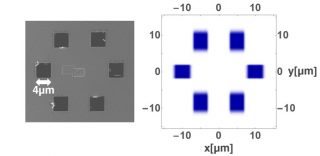Physicists at the Friedrich Alexander University Erlangen-Nürnberg (FAU), the University of Hamburg and the research facility DESY have succeeded for the first time in revealing tiny structures using an imaging method that relies on the usual diffraction of light, but which does not require the scattered light to be coherent. With conventional imaging methods using the diffraction of coherent light, scientists have to go to considerable lengths to ensure the coherence of the radiation, i.e. the electromagnetic waves must remain in phase during the scattering process. The new method uses incoherent light instead. The process, which has now been demonstrated for the first time using short-wave ultraviolet radiation, stands to revolutionise the methods of diffractive optics and has been published in the journal Nature Physics.

Diffraction image of a grating consisting of four slits, created using partially coherent light from the Free-Electron Laser Hamburg (FLASH), as used in the experiment. The coherent component of the FLASH radiation produces the horizontal diffraction pattern with a small number of pronounced maxima in its intensity; the incoherent component generates the so-called speckle pattern that can be seen above and below the coherent diffraction pattern. This is precisely the component of the light that was used by the new imaging method. Credit: Raimund Schneider et al.
For over 100 years, the diffraction of coherent X-rays has been used to determine the structure of crystals and molecules. The method relies on diffraction and interference, properties that are displayed by all waves: light waves, which are made up of photons, are deflected by the atoms in a crystal and interfere with each other. If a sufficient number of such photons are measured by a detector, they produce a characteristic diffraction image, which can be used to calculate the arrangement of the atoms within the crystal and hence its internal structure. However, this requires the waves to be scattered coherently. When the photons are not scattered coherently, in other words there is no fixed phase relationship between the incident and diffracted wave, conventional X-ray imaging methods are no longer able to supply information about the arrangement of the atoms.This effect limits the use of coherent diffractive X-ray imaging. “In the case of X-rays, incoherent scattering usually predominates, for example when fluorescent light is produced by photon absorption followed by photon emission,” explains Anton Classen from FAU, who is the principal author of a paper in which the method was first presented theoretically a few months ago. “This creates diffuse background radiation, which has until now been assumed to be unusable for imaging, instead reducing the fidelity of the imaging using coherent methods.”
Now, scientists have used the very same incoherent radiation to record a structure shaped like a benzene ring with the help of diffuse scattered light in the soft X-ray range at DESY’s free-electron laser FLASH. “Our work provides the basis for a fundamentally new approach to X-ray imaging, because our experiment has demonstrated that incoherently scattered photons can be used to reconstruct complex structures at short wavelengths,” explains Raimund Schneider of FAU, the principal author of the paper on the experimental findings.

Left: Electron microscope image of the hexagonal benzene ring structure investigated. Right: Reconstructed image of the benzene ring structure using the new method based on incoherent light. © Nature Physics [Source]
Reference:
Raimund Schneider, Thomas Mehringer, Giuseppe Mercurio, Lukas Wenthaus, Anton Classen, Günter Brenner, Oleg Gorobtsov, Adrian Benz, Daniel Bhatti, Lars Bocklage, Birgit Fischer, Sergey Lazarev, Yuri Obukhov, Kai Schlage, Petr Skopintsev, Jochen Wagner, Felix Waldmann, Svenja Willing, Ivan Zaluzhnyy, Wilfried Wurth, Ivan A. Vartanyants, Ralf Röhlsberger, Joachim von Zanthier
„Quantum Imaging with incoherently scattered light from a free-electron laser“
Nature Physics, 2017
DOI: 10.1038/nphys4301

